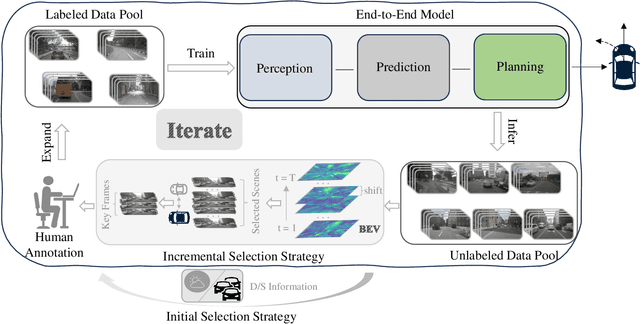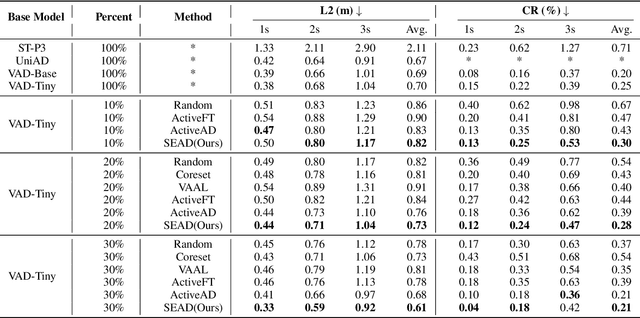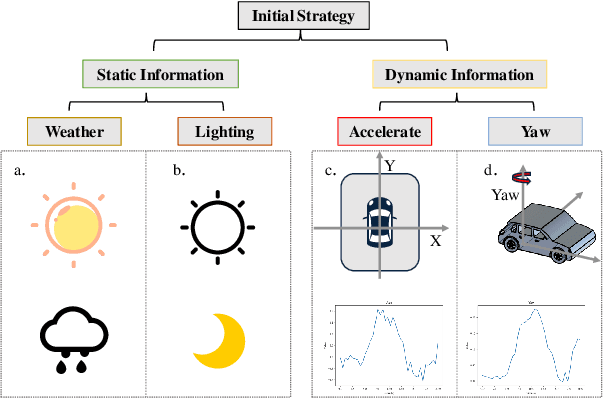Zhipeng Zhang
FlowDrive: Energy Flow Field for End-to-End Autonomous Driving
Sep 17, 2025Abstract:Recent advances in end-to-end autonomous driving leverage multi-view images to construct BEV representations for motion planning. In motion planning, autonomous vehicles need considering both hard constraints imposed by geometrically occupied obstacles (e.g., vehicles, pedestrians) and soft, rule-based semantics with no explicit geometry (e.g., lane boundaries, traffic priors). However, existing end-to-end frameworks typically rely on BEV features learned in an implicit manner, lacking explicit modeling of risk and guidance priors for safe and interpretable planning. To address this, we propose FlowDrive, a novel framework that introduces physically interpretable energy-based flow fields-including risk potential and lane attraction fields-to encode semantic priors and safety cues into the BEV space. These flow-aware features enable adaptive refinement of anchor trajectories and serve as interpretable guidance for trajectory generation. Moreover, FlowDrive decouples motion intent prediction from trajectory denoising via a conditional diffusion planner with feature-level gating, alleviating task interference and enhancing multimodal diversity. Experiments on the NAVSIM v2 benchmark demonstrate that FlowDrive achieves state-of-the-art performance with an EPDMS of 86.3, surpassing prior baselines in both safety and planning quality. The project is available at https://astrixdrive.github.io/FlowDrive.github.io/.
ReasoningTrack: Chain-of-Thought Reasoning for Long-term Vision-Language Tracking
Aug 07, 2025Abstract:Vision-language tracking has received increasing attention in recent years, as textual information can effectively address the inflexibility and inaccuracy associated with specifying the target object to be tracked. Existing works either directly fuse the fixed language with vision features or simply modify using attention, however, their performance is still limited. Recently, some researchers have explored using text generation to adapt to the variations in the target during tracking, however, these works fail to provide insights into the model's reasoning process and do not fully leverage the advantages of large models, which further limits their overall performance. To address the aforementioned issues, this paper proposes a novel reasoning-based vision-language tracking framework, named ReasoningTrack, based on a pre-trained vision-language model Qwen2.5-VL. Both SFT (Supervised Fine-Tuning) and reinforcement learning GRPO are used for the optimization of reasoning and language generation. We embed the updated language descriptions and feed them into a unified tracking backbone network together with vision features. Then, we adopt a tracking head to predict the specific location of the target object. In addition, we propose a large-scale long-term vision-language tracking benchmark dataset, termed TNLLT, which contains 200 video sequences. 20 baseline visual trackers are re-trained and evaluated on this dataset, which builds a solid foundation for the vision-language visual tracking task. Extensive experiments on multiple vision-language tracking benchmark datasets fully validated the effectiveness of our proposed reasoning-based natural language generation strategy. The source code of this paper will be released on https://github.com/Event-AHU/Open_VLTrack
EfficientVLA: Training-Free Acceleration and Compression for Vision-Language-Action Models
Jun 11, 2025Abstract:Vision-Language-Action (VLA) models, particularly diffusion-based architectures, demonstrate transformative potential for embodied intelligence but are severely hampered by high computational and memory demands stemming from extensive inherent and inference-time redundancies. While existing acceleration efforts often target isolated inefficiencies, such piecemeal solutions typically fail to holistically address the varied computational and memory bottlenecks across the entire VLA pipeline, thereby limiting practical deployability. We introduce EfficientVLA, a structured and training-free inference acceleration framework that systematically eliminates these barriers by cohesively exploiting multifaceted redundancies. EfficientVLA synergistically integrates three targeted strategies: (1) pruning of functionally inconsequential layers from the language module, guided by an analysis of inter-layer redundancies; (2) optimizing the visual processing pathway through a task-aware strategy that selects a compact, diverse set of visual tokens, balancing task-criticality with informational coverage; and (3) alleviating temporal computational redundancy within the iterative diffusion-based action head by strategically caching and reusing key intermediate features. We apply our method to a standard VLA model CogACT, yielding a 1.93X inference speedup and reduces FLOPs to 28.9%, with only a 0.6% success rate drop in the SIMPLER benchmark.
Structured Labeling Enables Faster Vision-Language Models for End-to-End Autonomous Driving
Jun 05, 2025Abstract:Vision-Language Models (VLMs) offer a promising approach to end-to-end autonomous driving due to their human-like reasoning capabilities. However, troublesome gaps remains between current VLMs and real-world autonomous driving applications. One major limitation is that existing datasets with loosely formatted language descriptions are not machine-friendly and may introduce redundancy. Additionally, high computational cost and massive scale of VLMs hinder the inference speed and real-world deployment. To bridge the gap, this paper introduces a structured and concise benchmark dataset, NuScenes-S, which is derived from the NuScenes dataset and contains machine-friendly structured representations. Moreover, we present FastDrive, a compact VLM baseline with 0.9B parameters. In contrast to existing VLMs with over 7B parameters and unstructured language processing(e.g., LLaVA-1.5), FastDrive understands structured and concise descriptions and generates machine-friendly driving decisions with high efficiency. Extensive experiments show that FastDrive achieves competitive performance on structured dataset, with approximately 20% accuracy improvement on decision-making tasks, while surpassing massive parameter baseline in inference speed with over 10x speedup. Additionally, ablation studies further focus on the impact of scene annotations (e.g., weather, time of day) on decision-making tasks, demonstrating their importance on decision-making tasks in autonomous driving.
More diverse more adaptive: Comprehensive Multi-task Learning for Improved LLM Domain Adaptation in E-commerce
Apr 09, 2025



Abstract:In recent years, Large Language Models (LLMs) have been widely applied across various domains due to their powerful domain adaptation capabilities. Previous studies have suggested that diverse, multi-modal data can enhance LLMs' domain adaptation performance. However, this hypothesis remains insufficiently validated in the e-commerce sector. To address this gap, we propose a comprehensive e-commerce multi-task framework and design empirical experiments to examine the impact of diverse data and tasks on LLMs from two perspectives: "capability comprehensiveness" and "task comprehensiveness." Specifically, we observe significant improvements in LLM performance by progressively introducing tasks related to new major capability areas and by continuously adding subtasks within different major capability domains. Furthermore, we observe that increasing model capacity amplifies the benefits of diversity, suggesting a synergistic relationship between model capacity and data diversity. Finally, we validate the best-performing model from our empirical experiments in the KDD Cup 2024, achieving a rank 5 in Task 1. This outcome demonstrates the significance of our research for advancing LLMs in the e-commerce domain.
Active Learning from Scene Embeddings for End-to-End Autonomous Driving
Mar 14, 2025



Abstract:In the field of autonomous driving, end-to-end deep learning models show great potential by learning driving decisions directly from sensor data. However, training these models requires large amounts of labeled data, which is time-consuming and expensive. Considering that the real-world driving data exhibits a long-tailed distribution where simple scenarios constitute a majority part of the data, we are thus inspired to identify the most challenging scenarios within it. Subsequently, we can efficiently improve the performance of the model by training with the selected data of the highest value. Prior research has focused on the selection of valuable data by empirically designed strategies. However, manually designed methods suffer from being less generalizable to new data distributions. Observing that the BEV (Bird's Eye View) features in end-to-end models contain all the information required to represent the scenario, we propose an active learning framework that relies on these vectorized scene-level features, called SEAD. The framework selects initial data based on driving-environmental information and incremental data based on BEV features. Experiments show that we only need 30\% of the nuScenes training data to achieve performance close to what can be achieved with the full dataset. The source code will be released.
OmniSTVG: Toward Spatio-Temporal Omni-Object Video Grounding
Mar 13, 2025Abstract:In this paper, we propose spatio-temporal omni-object video grounding, dubbed OmniSTVG, a new STVG task that aims at localizing spatially and temporally all targets mentioned in the textual query from videos. Compared to classic STVG locating only a single target, OmniSTVG enables localization of not only an arbitrary number of text-referred targets but also their interacting counterparts in the query from the video, making it more flexible and practical in real scenarios for comprehensive understanding. In order to facilitate exploration of OmniSTVG, we introduce BOSTVG, a large-scale benchmark dedicated to OmniSTVG. Specifically, our BOSTVG consists of 10,018 videos with 10.2M frames and covers a wide selection of 287 classes from diverse scenarios. Each sequence in BOSTVG, paired with a free-form textual query, encompasses a varying number of targets ranging from 1 to 10. To ensure high quality, each video is manually annotated with meticulous inspection and refinement. To our best knowledge, BOSTVG is to date the first and the largest benchmark for OmniSTVG. To encourage future research, we introduce a simple yet effective approach, named OmniTube, which, drawing inspiration from Transformer-based STVG methods, is specially designed for OmniSTVG and demonstrates promising results. By releasing BOSTVG, we hope to go beyond classic STVG by locating every object appearing in the query for more comprehensive understanding, opening up a new direction for STVG. Our benchmark, model, and results will be released at https://github.com/JellyYao3000/OmniSTVG.
Disentangled World Models: Learning to Transfer Semantic Knowledge from Distracting Videos for Reinforcement Learning
Mar 11, 2025Abstract:Training visual reinforcement learning (RL) in practical scenarios presents a significant challenge, $\textit{i.e.,}$ RL agents suffer from low sample efficiency in environments with variations. While various approaches have attempted to alleviate this issue by disentanglement representation learning, these methods usually start learning from scratch without prior knowledge of the world. This paper, in contrast, tries to learn and understand underlying semantic variations from distracting videos via offline-to-online latent distillation and flexible disentanglement constraints. To enable effective cross-domain semantic knowledge transfer, we introduce an interpretable model-based RL framework, dubbed Disentangled World Models (DisWM). Specifically, we pretrain the action-free video prediction model offline with disentanglement regularization to extract semantic knowledge from distracting videos. The disentanglement capability of the pretrained model is then transferred to the world model through latent distillation. For finetuning in the online environment, we exploit the knowledge from the pretrained model and introduce a disentanglement constraint to the world model. During the adaptation phase, the incorporation of actions and rewards from online environment interactions enriches the diversity of the data, which in turn strengthens the disentangled representation learning. Experimental results validate the superiority of our approach on various benchmarks.
Contourlet Refinement Gate Framework for Thermal Spectrum Distribution Regularized Infrared Image Super-Resolution
Nov 19, 2024



Abstract:Image super-resolution (SR) is a classical yet still active low-level vision problem that aims to reconstruct high-resolution (HR) images from their low-resolution (LR) counterparts, serving as a key technique for image enhancement. Current approaches to address SR tasks, such as transformer-based and diffusion-based methods, are either dedicated to extracting RGB image features or assuming similar degradation patterns, neglecting the inherent modal disparities between infrared and visible images. When directly applied to infrared image SR tasks, these methods inevitably distort the infrared spectral distribution, compromising the machine perception in downstream tasks. In this work, we emphasize the infrared spectral distribution fidelity and propose a Contourlet refinement gate framework to restore infrared modal-specific features while preserving spectral distribution fidelity. Our approach captures high-pass subbands from multi-scale and multi-directional infrared spectral decomposition to recover infrared-degraded information through a gate architecture. The proposed Spectral Fidelity Loss regularizes the spectral frequency distribution during reconstruction, which ensures the preservation of both high- and low-frequency components and maintains the fidelity of infrared-specific features. We propose a two-stage prompt-learning optimization to guide the model in learning infrared HR characteristics from LR degradation. Extensive experiments demonstrate that our approach outperforms existing image SR models in both visual and perceptual tasks while notably enhancing machine perception in downstream tasks. Our code is available at https://github.com/hey-it-s-me/CoRPLE.
Temporal Correlation Meets Embedding: Towards a 2nd Generation of JDE-based Real-Time Multi-Object Tracking
Jul 19, 2024



Abstract:Joint Detection and Embedding(JDE) trackers have demonstrated excellent performance in Multi-Object Tracking(MOT) tasks by incorporating the extraction of appearance features as auxiliary tasks through embedding Re-Identification task(ReID) into the detector, achieving a balance between inference speed and tracking performance. However, solving the competition between the detector and the feature extractor has always been a challenge. Also, the issue of directly embedding the ReID task into MOT has remained unresolved. The lack of high discriminability in appearance features results in their limited utility. In this paper, we propose a new learning approach using cross-correlation to capture temporal information of objects. The feature extraction network is no longer trained solely on appearance features from each frame but learns richer motion features by utilizing feature heatmaps from consecutive frames, addressing the challenge of inter-class feature similarity. Furthermore, we apply our learning approach to a more lightweight feature extraction network, and treat the feature matching scores as strong cues rather than auxiliary cues, employing a appropriate weight calculation to reflect the compatibility between our obtained features and the MOT task. Our tracker, named TCBTrack, achieves state-of-the-art performance on multiple public benchmarks, i.e., MOT17, MOT20, and DanceTrack datasets. Specifically, on the DanceTrack test set, we achieve 56.8 HOTA, 58.1 IDF1 and 92.5 MOTA, making it the best online tracker that can achieve real-time performance. Comparative evaluations with other trackers prove that our tracker achieves the best balance between speed, robustness and accuracy.
 Add to Chrome
Add to Chrome Add to Firefox
Add to Firefox Add to Edge
Add to Edge